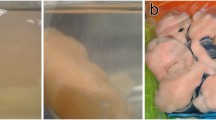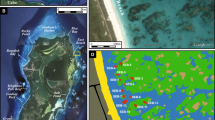Abstract
Experimental etching with hydrofluoric acid indicated that silica deposition occurs in a recognizable pattern in common sponge microscleres. The postdepositional alteration of these spicules has previously been generally unrecognized or misinterpreted in the literature. Early stages of postdepositional etching of sponge spicules were observed in the acid insoluble fraction of sediments from the West Atlantic barrier reef near Carrie Bow Cay, Belize. Preliminary data on silica distribution in the Belize barrier reef show that concentrations in fine sediment (<0.25 mm) increase landward of the main reef tract. Sponge spicules are the main component of particulate silica in sediments of the reef and fore-reef where sponge populations abound, whereas grains prevail in the back-reef lagoon deposits. Recycling of locally dissolved silica appears to be important for the growth of many off-shore reef sponges.
Similar content being viewed by others
Literature Cited
Arrhenius, G.: Pelagic sediments. In: The sea. Vol. 3. The earth beneath the sea history, pp 655–727. Ed. by M.N. Hill. New York and London: Wiley-Interscience 1963
Brien, P.: Les démosponges, morphologie et reproduction. Traité Zool. 3, 133–461 (1973)
Dayton, P.K., G.A. Robilliard, R.T. Paine and L.B. Dayton: Biological accommodation in the benthic community at McMurdo Sound, Antarctica. Ecol. Monogr. 44, 105–128 (1974)
Dendy, A.: The tetraxonid sponge spicule, a study in evolution. Acta zool., Stock. 2, 95–152 (1921a)
—: Report on the Sigmatotetraxonida collected by H.M.S. “Sealark” in the Indian Ocean. Trans. Linn. Soc. Lond. (Ser. 2. Zool.) 18, 1–164 (1921b)
Duncan, P.M.: On some remarkable enlargements of the axial canals of sponge spicules and their causes. Jl R. microsc. Soc. (Ser. 2) 1, 557–572 (1881)
Elvin, D.: Growth rates of the siliceous spicules of the freshwater sponge Ephydatia muelleri (Lieberkühn). Trans. Am. microsc. Soc. 90, 219–224 (1971)
Fanning, K.A. and M.E.Q. Pilson: The diffusion of dissolved silica out of deep-sea sediments. J. geophys. Res. 79, 1293–1297 (1974)
Friedman, G.M., S.A. Ali and D.H. Krimsley: Dissolution of quartz accompanying carbonate precipitation and cementation in reefs: example from the Red Sea. J. sedim. Petrol. 46, 970–973 (1976)
Garrone, R.: Collagéne, spongine et squelette minéral chez l'éponge Haliclona rosea (O.S.) (Démosponge, Haploscléride). J. Microscopie 8, 581–598 (1969)
Gray, J.E.: On Placospongia, a new generic form of Spongiadae in the British Museum. Proc. zool. Soc. Lond. 1867, 127–219 (1867)
Hartman, W.D. and T.F. Goreau: Jamaican coralline sponges: their morphology, ecology and fossil relatives. In: The biology of the Porifera, pp 205–243. Ed. by W.G. Fry. London: Academic Press 1970
Hinde, G.J.: On a new genus of siliceous sponges from the lower calcareous grit of Yorkshire. Q. Jl geol. Soc. Lond. 46, 54–61 (1890)
Huang, T.: A new Radiolaria from the Sōmachi Formation, Kikai-jima, Kagoshima Prefecture, Japan. Trans. Proc. palaeont. Soc. Japan (N.S.) 68, 177–184 (1967)
Hurd, D.C.: Factors affecting solution rate of biogenic opal in seawater. Earth planet. Sci. Letters 15, 411–417 (1972)
Inoue, M. and Y. Iwasaki: A problematic micro-organism similar to the sterraster of sponges. Proc. Japan Acad. 51, 273–278 (1975)
Jewell, M.E.: An ecological study of the freshwater sponges of northern Wisconsin. Ecol. Monogr. 5, 461–504 (1935)
Jørgensen, C.B.: On the spicule-formation of Spongilla lacustris (L.) I. The dependence of the spicule formation on the content of dissolved and solid silicic acid of the milieu. Biol. Meddr 19, 1–45 (1944)
Koltun, V.M.: Spicules of sponges as an element of the bottom sediments of the Antarctic. In: Symposium on Antartic Oceanography, Santiago, Chile, 1966, pp 121–123. Cambridge: Scott Polar Research Institute 1968
Land, L.S.: Early dissolution of sponge spicules from reef sediments, North Jamaica. J. sedim. Petrol. 46, 967–969 (1976)
Macintyre, I.G.: Distribution of submarine cements in a modern Caribbean fringing reef, Galeta Point, Panama. J. sedim. Petrol. 47, 503–516 (1977)
Moore, C.H. and W.W. Shedd: Effective rates of sponge bioerosion as a function of carbonate production. Proc. 3rd int. Symp. coral Reefs 2, 500–505 (1977). Ed. by D.L. Taylor. Miami: School of Marine and Atmospheric Sciences, University of Miami
Neumann, A.C.: Observations on coastal erosion in Bermuda and measurement of the boring rate of the sponge, Cliona lampa. Limnol. Oceanogr. 11, 92–108 (1966)
Pé, J.: Étude quantitative de la régulation du squelette chez und éponge d'eau douce. Archs Biol., Bruxelles 84, 147–173 (1973)
Reid, R.E.H.: Microscleres in demosponge classification. Paleont. Contr. Univ. Kans. 35, 1–37 (1968)
Reif, W.-E.: Schwammspicula aus dem weißen Jura Zeta von Nattheim (Schwäbische Alb). Paleontographica (Abt. A) 127, 85–102 (1967)
Reiswig, H.M.: The axial symmetry of sponge spicules and its phylogenetic significance. Cah. Biol. mar. 12, 505–514 (1971)
—: Population dynamics of three Jamaican Demospongiae. Bull. mar. Sci. 23, 191–226 (1973)
Riley, J.P. and R. Chester: Introduction to marine chemistry, 465 pp. London and New York: Academic Press 1971
Rützler, K.: The role of burrowing sponges in bioerosion. Oecologia (Berl.) 19, 203–216 (1975)
—: Sponges in coral reefs. In: Coral reefs: research methods, pp 299–313. Ed. by D.R. Stoddart and R.E. Johannes, Paris: UNESCO 1978
Schindewolf, O.H.: Analyse eines Ammoniten-Gehäuses. Abh. math.-naturw. Kl. Akad. Wiss. Mainz 8, 135–188 (1967)
Schrammen, A.: Die Kieselspongien des oberen Jura von Süddeutschland. A. Vorwort und allgemeiner Teil. Palaeontographica (Abt. A) 84, 149–194 (1936)
Schwab, D.W. and R.E. Shore: Mechanism of internal stratification of siliceous sponge spicules. Nature, Lond. 232, 501–502 (1971)
Sollas, W.J.: Report on the Tetractinellida collected by H.M.S. Challenger, during the years 1873–1876. Rep. scient. Results Voyage HMS Challenger (Zool.) 25, i-clxvi, 1–458 (1888)
Strickland, J.D.H. and T.R. Parsons: A practical handbook of seawater analysis. Bull. Fish. Res. Bd Can. 167, 1–311 (1968)
Vosmaer, G.C.J. and J.H. Vernhout: The Porifera of the Siboga Expedition. I. The genus Placospongia. Siboga Exped. 6A, 1–17 (1902)
Weaver, C.E. and K.C. Beck: Miocene of the S.E. United States: a model for chemical sedimentation in a peri-marine environment. Sedimentary Geol. 17, 1–234 (1977)
Author information
Authors and Affiliations
Additional information
Communicated by M.R. Tripp, Newark
Rights and permissions
About this article
Cite this article
Rützler, K., Macintyre, I.G. Siliceous sponge spicules in coral reef sediments. Mar. Biol. 49, 147–159 (1978). https://doi.org/10.1007/BF00387114
Accepted:
Issue Date:
DOI: https://doi.org/10.1007/BF00387114




